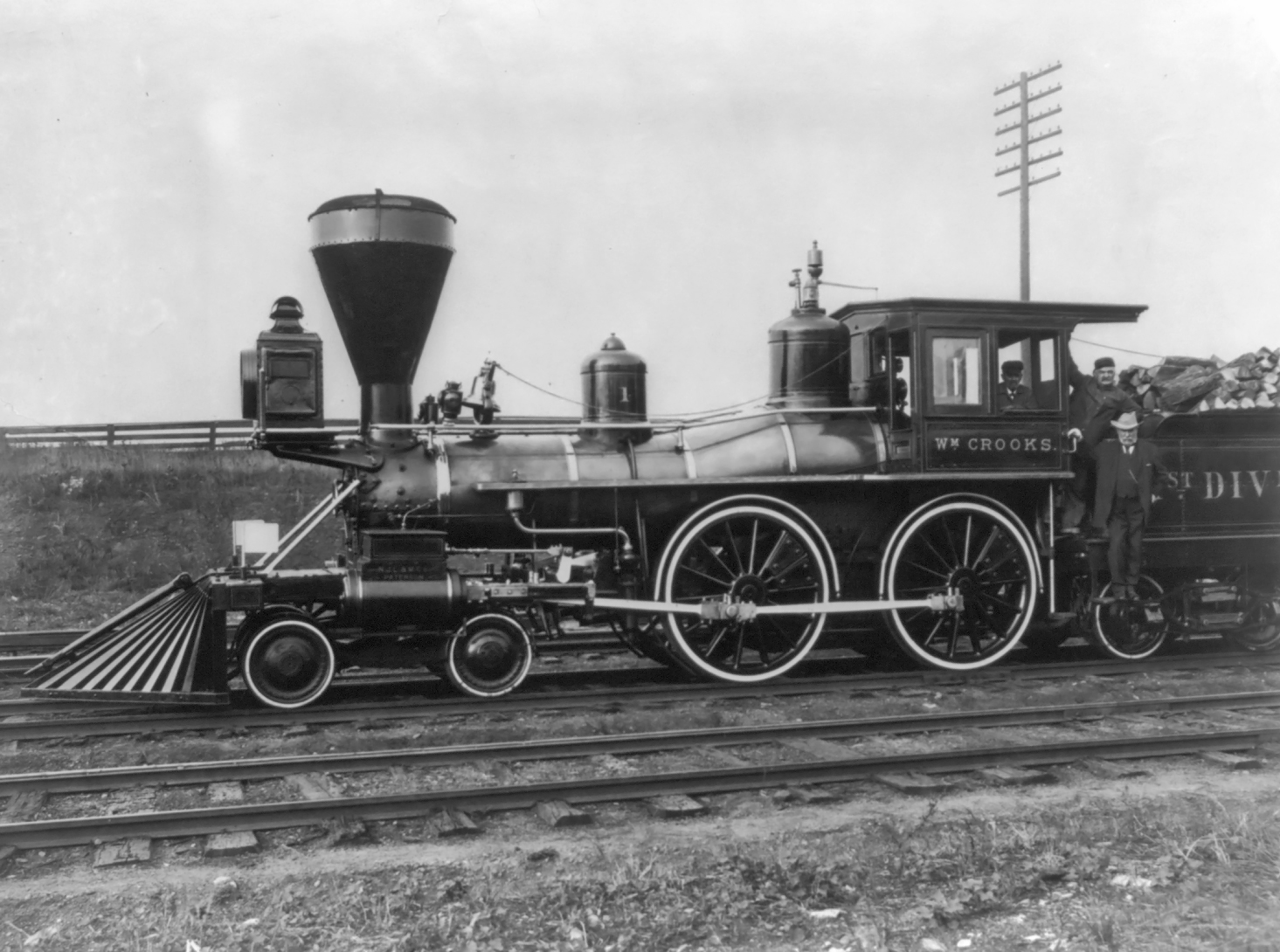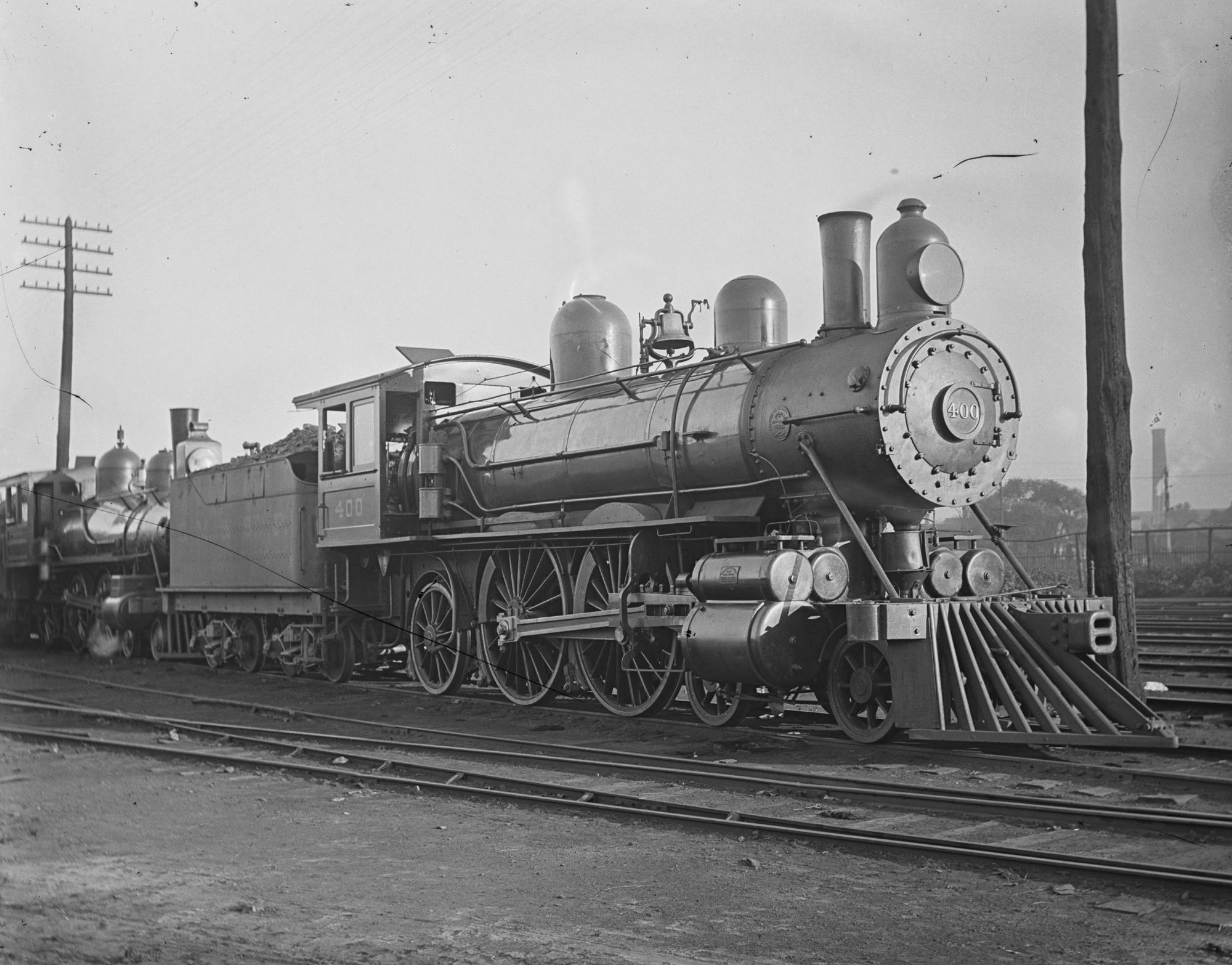Railroad Cowcatcher: Purpose, History, Photos
Published: February 21, 2025
By: Adam Burns
The cowcatcher, known by various names such as the pilot, buffer, and fender, is a prominent device affixed to the front of locomotives. Highly recognizable and distinctive, it played a significant role in the history of rail transportation. Its primary purpose was practical, aiming to clear the track of obstacles, thereby ensuring safety and efficiency in railway operations.
 James J. Hill's first engine, the 4-4-0 "William Crooks," is seen here circa 1908 with Mr. Hill himself posing on the cab steps. Note its prominent cowcatcher.
James J. Hill's first engine, the 4-4-0 "William Crooks," is seen here circa 1908 with Mr. Hill himself posing on the cab steps. Note its prominent cowcatcher.Historical Background
The inception of the cowcatcher can be traced back to the early days of railway development in the early to mid-19th century. During this era, railroads were expanding quickly across the United States and Europe, and steam locomotives were becoming the primary vehicles of transportation.
In 1830, during his tenure with the Liverpool and Manchester Railway, Charles Babbage proposed a concept for a cowcatcher. Despite his efforts, Babbage's design was never materialized, and it remains ambiguous whether subsequent manufacturers were cognizant of his proposal.
The implementation of the first operational cowcatcher is largely attributed to Isaac Dripps. He attached the device to the John Bull locomotive in 1833, shortly after the inauguration of steam-powered transport on the Camden and Amboy Railroad. David Stevenson's 1838 publication, "Sketch of the Civil Engineering of North America," provides a delineation and illustration of Dripps's design.
The term "cowcatcher" originated in the United States around the 1830s, coinciding with the rapid expansion of the rail networks. As locomotives surged forth, they brought with them both the promise of progress and a new set of challenges. Among these challenges was the need to traverse vast rural areas where livestock, particularly cattle, roamed freely, often wandering onto the tracks.
Railway workers were compelled to confront the reality of collisions. These incidents did not only involve livestock but also included debris and other obstructions. Such collisions could cause substantial damage to the locomotive, lead to derailments, and potentially result in severe injuries to passengers and crew.
Design and Evolution
Initially, the design of a cowcatcher was relatively straightforward, typically consisting of a V-shaped frame attached to the front of the locomotive. The construction often involved iron or steel, materials that provided the necessary strength to withstand impacts. Some designs were more rudimentary, made of wood, and later reinforced with metal as the technology advanced.
The cowcatcher operates by catching and pushing obstacles away from the tracks, preventing harm to the locomotive and reducing the risks of derailments. It effectively deflected objects to the sides, minimizing the potential for frontal impacts. Its angular design was intentional, using the principle of natural deflection to steer items away from the locomotive's path.
As railways expanded into various terrains and diverse regions, so did the design variations of cowcatchers. Some areas required larger and more robust versions due to frequent encounters with large animals or substantial debris. In contrast, other areas with less traffic or impediments saw simpler, more streamlined versions.
Technological Advancements
With technological advancements, cowcatcher designs evolved, often reflecting the characteristics of the locomotives they adorned. By the late 19th century, the integration of more efficient materials and the improvement in locomotive engineering led to more refined cowcatchers. These became more aesthetic in appearance, mirroring the growing recognition of railway companies for the importance of brand image.
Besides the traditional V-shaped design, other styles surfaced, including bar-type cowcatchers and those with grille designs. The grid-like pattern helped ensure smaller debris could be effectively managed without compromising the overall structural integrity of the cowcatcher itself.
Purpose and Functionality
While originally intended to remove livestock from the tracks, over time, the cowcatcher's role broadened. It became adept at handling various debris, including stones, wood logs, and other potentially hazardous materials. This adaptation made rail travel considerably safer and more reliable.
Rail companies quickly realized the cowcatcher's potential in reducing maintenance costs. By mitigating track obstructions, these devices decreased the likelihood of damage to the undercarriage of locomotives. This not only prevented expensive repairs but also contributed to maintaining punctuality, which was vital to operational efficiency and passenger satisfaction.
Cultural Impact
The cowcatcher is also an emblem of the steam locomotive era, intrinsically linked to the romanticized image of the Old West and the pioneers who ventured into uncharted territories. Depictions of rugged steam engines plowing through landscapes with cowcatchers leading the charge became iconic, cementing their place in popular culture.
In literature and film, the cowcatcher is often portrayed as an indispensable piece of railway lore, symbolizing innovation and industrial dominance. Its image became synonymous with progress and adventure during the era of great American expansion, an era when railroads were the driving force behind economic growth and migration.
Decline and Modernization
With the advent of diesel and electric locomotives, along with significant improvements in railway infrastructure, the need for the traditional cowcatcher has diminished. Modern railroads benefit from developed areas with fencing to keep livestock away, sophisticated signaling systems, and better track maintenance which reduces the occurrence of obstacles.
Despite this decline in utilitarian necessity, the cowcatcher is still appreciated for its historical significance. Some modern locomotives may still feature cowcatcher-like designs, albeit more for nostalgic and aesthetic reasons rather than functional necessity.
Conclusion
In summary, the cowcatcher is a testament to the innovative spirit of the early railway era. It effectively addressed the challenges faced by pioneer railroaders, contributing significantly to making rail travel safer and more efficient. Though its functional role has largely been replaced by technological and infrastructural advancements, the cowcatcher endures as an emblem of railway heritage—a symbol that captures a transformative time in industrial history. Its legacy lives on in the iconic imagery of the steam locomotive, a powerful reminder of a bygone era that shaped the modern world.
Recent Articles
-
New Mexico Railroad Museums: A Complete Guide
Apr 23, 25 02:25 PM
The enchanting state of New Mexico, known for its vivid landscapes and rich cultural heritage, is home to a number of fascinating railroad museums. -
New Hampshire Railroad Museums: A Complete Guide
Apr 23, 25 02:11 PM
New Hampshire, known for its breathtaking landscapes, historic towns, and vibrant culture, also boasts a rich railroad history that has been meticulously preserved and celebrated across various museum… -
Minnesota Railroad Museums: A Complete Guide
Apr 22, 25 12:17 PM
The state of Minnesota has always played an important role with the railroad industry, from major cities to agriculture. Today, several museums can be found throughout the state.
